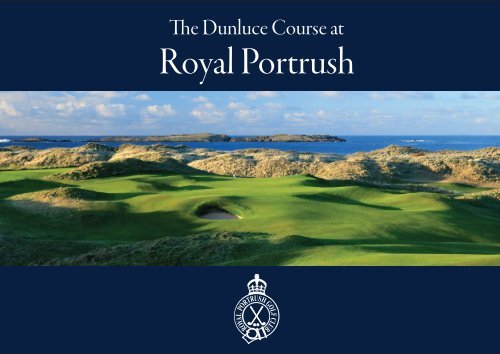Create successful ePaper yourself
Turn your PDF publications into a flip-book with our unique Google optimized e-Paper software.
The Dunluce Course - True Links<br />
David Cannon Collection/Getty Images
Introduction<br />
The purpose of this booklet is to present the adjustments which have been made<br />
to the famed Dunluce Course at <strong>Royal</strong> <strong>Portrush</strong>. The reason for the adjustments is<br />
twofold - To increase the quality of the links for regular member and visitor play<br />
and to provide a course which is suitable for <strong>Royal</strong> <strong>Portrush</strong> to host the 148th<br />
<strong>Open</strong>. However, the overriding principle has been to ensure that the members<br />
and visitors enjoy the Dunluce Course even more than before.<br />
As part of the overall course review exercise, investigation of the evolution of golf<br />
at <strong>Portrush</strong> was undertaken to assess how the layout has changed over the years<br />
and especially since Harry Colt laid out his final design for the Dunluce Course<br />
in 1932. That has highlighted a fundamental issue. When Harry Colt designed<br />
the Dunluce in 1932, the clubhouse was over 1,200 yards away from the present<br />
clubhouse in the town of <strong>Portrush</strong>. Two of his original holes - the key 1st & 18th<br />
holes - are now lost. They provided a link from the old clubhouse to the old<br />
17th and 18th holes. The 8th and 9th in the previous layout (now the 10th and<br />
11th) did not exist. Although Harry Colt was consulted over the addition of the<br />
replacement 8th and 9th holes and approved of them, they were the conception<br />
of the Club’s professional, P.G. Stevenson, and Colt was not involved with the<br />
detail of the holes. This shows that Harry Colt was open to adjustments to the<br />
course required by changing circumstances.<br />
Would Harry Colt advocate such a change if he were alive today? We believe that<br />
he certainly would. Not just because the prize of The <strong>Open</strong> awaited but also due<br />
to the fact that the adjustments strengthen the layout. He would always look<br />
for the best land for his designs and the new holes have occupied arguably the<br />
strongest land which <strong>Portrush</strong> has to offer.<br />
Have the changes led to more enjoyment for the members and visitors through<br />
an increase in quality of the course? There is little doubt that the two new holes<br />
are far superior in natural character compared with the old 17th and 18th holes.<br />
That, on its own, has led to the course receiving even greater plaudits than it did<br />
before and will hopefully continue to generate more enjoyment in the play of the<br />
course for all golfers.<br />
The Land Of The Old<br />
17th & 18th<br />
The Current<br />
Clubhouse<br />
The Club is now at another juncture of its evolution with the changes made to<br />
the course to make it possible for the 148th <strong>Open</strong> to return to <strong>Royal</strong> <strong>Portrush</strong>.<br />
The Championship has grown in scale tremendously since Max Faulkner lifted the<br />
Claret Jug when the event was held over the links in 1951. The R&A was clear from<br />
the outset of the negotiations for the return of The <strong>Open</strong> that sufficient room<br />
had to be available in the right areas to allow all of the usual infrastructure to be<br />
put in place to support the Championship. Following an intensive study of all<br />
options, the inescapable conclusion was drawn that the old 17th and 18th holes<br />
of the Dunluce Course would have to be made available for the majority of the<br />
spectator village area.<br />
Following a detailed study of the opportunities to replace the old 17th and 18th<br />
holes, the conclusion was that two replacement holes for the Dunluce could be<br />
forged from the area previously occupied by the 5th and 6th holes of the Valley<br />
Course. This is a tremendous arena for two dramatic and iconic holes which should<br />
quickly achieve world fame. That led to two questions.<br />
Lady Margaret Scott on the old 18th green at the original clubhouse during the<br />
Ladies’ British <strong>Open</strong> Amateur Championship in 1895.
Heritage<br />
Mackenzie & Ebert have the utmost respect for the work of the<br />
great architects of the past and especially that of Harry Colt. Any<br />
changes to <strong>Royal</strong> <strong>Portrush</strong> have been made in the spirit and style of<br />
his original design.<br />
The land in the ‘Triangle’ providing two of Harry Colt’s original holes was fine links ground. It<br />
would have provided wonderful start and finish holes for his course.<br />
Those holes linked to the old 17th & 18th holes.<br />
The old clubhouse sat high on the hill right in the heart of the town of <strong>Portrush</strong>.
Heritage - Layout Before Harry Colt Redesigned The Course<br />
The Long Course used to be a completely different configuration and occupied land now taken up by the Valley & Skerries Courses.<br />
The existing Tavern<br />
location<br />
The ‘Triangle’ - No longer part<br />
of the course<br />
The current Clubhouse<br />
Location
Heritage - Plan Showing the 1911 & 1991 (Current Day) Layouts<br />
The extra land to the north (right hand side of the plan) which became available to Colt was substantial allowing a complete change of layout for<br />
both courses but his focus was on the original clubhouse location.<br />
The existing Tavern<br />
location<br />
The ‘Triangle’ - No<br />
longer part of the course<br />
The current Clubhouse<br />
Location
Heritage - Plan Showing the Original & Current Day Clubhouse Locations<br />
The original Clubhouse<br />
Location<br />
The current Clubhouse<br />
Location
Heritage - Aerial Photo Showing the Original & Current Day Clubhouse Locations<br />
The original Clubhouse<br />
Location<br />
Old 17th<br />
Old 18th<br />
The current Clubhouse<br />
Location
Photographs Courtesy of <strong>Royal</strong> <strong>Portrush</strong><br />
Heritage - Original Course Character
The Two New Holes<br />
If there had been a criticism of the Dunluce Course over the years, it was that<br />
the old 17th and 18th holes were slightly weak after such an amazing tour of<br />
the dunes over the first 16 holes. That has been addressed by creating two new<br />
holes that continue to improve Colt’s finest links. The dunescape which they<br />
occupy is second to none, giving rise to two holes which are more in-keeping<br />
with the other 16 holes on the course.<br />
Firstly, a new par 5 hole plays down into the valley, over the route of the old<br />
6th hole of the Valley Course and rises gently up to a new green, hugging the<br />
enormous dunes to its right. ‘Big Nellie’, a huge bunker on the old 17th hole,<br />
has been recreated to the right of this new hole. This fits very well into the<br />
huge dune bank.<br />
Secondly, a new par 4 hole has the potential to become one of the most<br />
dramatic in championship golf and one of the main feature holes of the<br />
Dunluce Course. From a tee position close to the old 5th tee on the Valley, the<br />
golfer faces a demanding drive played across the chasm of the valley between<br />
tee and fairway to a green close to the existing 8th green.<br />
The two holes fit in perfectly between the 6th and the old 7th hole and make<br />
up for the considerable loss of length from the removal of the old 17th and<br />
18th holes.<br />
These two new holes have the potential to become not only famous but iconic<br />
throughout the world of golf.<br />
The new 7th hole<br />
David Cannon Collection/Getty Images
The Two New Holes<br />
Old Valley 6th Tees<br />
7<br />
Old Valley 5th Green<br />
Old Valley 6th Green<br />
Old Valley 5th Tees<br />
8
The Dunluce Links Course Overview<br />
7<br />
8<br />
6<br />
5<br />
16<br />
10<br />
15<br />
Valley Links<br />
9<br />
11<br />
17<br />
Dunluce Links<br />
4<br />
14<br />
18<br />
1<br />
13<br />
12<br />
3<br />
2
David Cannon Collection/Getty Images
The Changes To The Original Dunluce Holes<br />
Along with the two new holes which have been created, the other sixteen holes<br />
of the course were reviewed to assess where appropriate adjustment would be<br />
merited. This was carried out in conjunction with officers of the Club and The R&A.<br />
However, any improvements implemented have borne in mind the fact that the<br />
course is used as a private members’ facility for the vast majority of its life. Hence any<br />
changes have been implemented so that they do not compromise the enjoyment<br />
of the members. A few back tees have been added which will not be used by the<br />
members and the addition of bunkers or adjustment of the landform carried out<br />
affects, on the whole, the landing areas of the elite players rather than the handicap<br />
golfers.<br />
It is interesting to note that there have been no major changes to any of the par 3<br />
holes on the course other than adding a back tee at the famous Calamity. Without<br />
exception they have all withstood the test of time. However, adjustments have been<br />
made to every other hole although a number of them are relatively minor in nature.<br />
In terms of lengthening the holes and the course, there was no target set for the<br />
overall length of the layout. Instead each hole has been considered on an individual<br />
basis and to ensure an even balance of lengths of holes throughout the course.<br />
That has led to an overall length of 7,344 yards - An increase of 201 yards from the<br />
previous 7,143 yards.<br />
The quality of the contouring of the greens and surrounds on the course is the<br />
element which fundamentally defines the skills of Harry Colt and his construction<br />
team. There are some wonderful shapes to admire. There was further evidence of<br />
this by a comparison of the true ‘Colt’ greens with the surfaces of the old 8th and 9th<br />
which did not benefit from his attention to detail as these holes were added later.<br />
There was a marked difference in their shapes and the way they blend into their<br />
surroundings although the old 9th (new 11th) sits better in the landscape than the<br />
old 8th (new 10th) did. Hence the 10th green was reshaped during the works to<br />
provide it with a surface which we think Mr Colt would approve of.<br />
As with the design concept for the two new holes, any adjustments to the existing<br />
holes have paid respect to the original design philosophy of Harry Colt. He made<br />
very sparing use of bunkers at <strong>Portrush</strong>. The nature of terrain and the penalty of<br />
the rough would have rendered over reliance on bunkers unnecessary. There is<br />
little doubt that the standard of play has increased over the years but the revised<br />
course still only relies on 59 with the number of new ones balancing the number<br />
of bunkers removed. That is far lower than any other <strong>Open</strong> venue. Turnberry is the<br />
closest having 87 bunkers with the majority of the venues having around 100,<br />
Muirfield more than 150 and <strong>Royal</strong> Lytham & St Annes relied on as many as 203 the<br />
last time The <strong>Open</strong> was held there!<br />
Par 5 holes generally require attention to ensure that they still ask the right questions<br />
of the best players. That has proved to be the case at <strong>Royal</strong> <strong>Portrush</strong>. The most<br />
dramatic of the changes to the par 5s was to lengthen the 2nd hole by pushing<br />
the green further back. That seemed to be a natural opportunity to implement<br />
although the hole is still reachable with two well struck shots. The 11th hole (old<br />
9th) has been played as a par 5 in the past but, at less than 480 yards, it will be<br />
played as a par 4 for The <strong>Open</strong>. The 12th hole (the old 10th) has been lengthened<br />
just for the elite players with tees to the left of the preceding green. The old 17th<br />
has been replaced with the new 7th hole and this includes the recreation of the<br />
fearsome ‘Big Nellie’ bunker.<br />
David Cannon Collection/Getty Images
The Valley Course Overview<br />
13<br />
14<br />
12<br />
10<br />
16<br />
11<br />
5<br />
4<br />
17<br />
15<br />
Valley Links<br />
9<br />
8<br />
6<br />
18<br />
7<br />
3<br />
1 2<br />
Dunluce Links
Mackenzie & Ebert<br />
Tom Mackenzie & Martin Ebert have been designing and redesigning golf courses since<br />
1989, first with Donald Steel & Company and then, from 2005, as Mackenzie & Ebert<br />
Ltd. The company has provided golf course architectural advice to <strong>Royal</strong> <strong>Portrush</strong> Golf<br />
Club on both the Dunluce and Valley Courses since Mackenzie & Ebert was formed.<br />
Martin Ebert has been the partner in charge of the work and this followed the input<br />
which he made with Donald Steel from 2001 until 2005.<br />
In that time the projects which have been undertaken at the Club have included the<br />
improvement of the practice ground, the creation of the short game practice area, the<br />
installation of back tees on a number of holes as well as general advice regarding both<br />
the Dunluce and Valley Courses. Over the past five years, this major project at <strong>Royal</strong><br />
<strong>Portrush</strong> has been one of the most prominent handled by the company to ensure that<br />
the Dunluce Course is as good as it can be for the return of The <strong>Open</strong> to <strong>Royal</strong> <strong>Portrush</strong>.<br />
Mackenzie & Ebert currently advise 7 of the 10 current <strong>Open</strong> Championship venues,<br />
the feted <strong>Royal</strong> Dornoch in Scotland, <strong>Royal</strong> Porthcawl in Wales, <strong>Royal</strong> County Down in<br />
Northern Ireland and Portmarnock in Ireland amongst a long portfolio of links courses.<br />
The Championship links of Turnberry, <strong>Royal</strong> St. George’s, <strong>Royal</strong> Lytham & St Annes,<br />
<strong>Royal</strong> Troon, Carnoustie and <strong>Royal</strong> Liverpool have to present an enjoyable experience<br />
for members and visitors as well as the supreme test of the world’s best players.<br />
Striking the right balance is the key as well as paying due respect to the wonderful<br />
heritage of these courses.<br />
Those same skills learned from working on so many classic championship courses<br />
have been brought to bear on the planning and implementation of the adjustments<br />
to the Dunluce Course which has enabled it to once again host The <strong>Open</strong>. This has<br />
involved a close working relationship with the Club and The R&A.<br />
Carnoustie
<strong>Royal</strong> St. George’s<br />
<strong>Royal</strong> Troon<br />
<strong>Royal</strong> Lytham & St. Annes<br />
Photograph Courtesy of <strong>Royal</strong> St. George’s<br />
Photograph Courtesy of Kenneth Ferguson Photography<br />
Photograph Courtesy of Mark Alexander<br />
Turnberry
David Cannon Collection/Getty Images
David Cannon Collection/Getty Images
David Cannon Collection/Getty Images
David Cannon Collection/Getty Images
David Cannon Collection/Getty Images
David Cannon Collection/Getty Images
David Cannon Collection/Getty Images
David Cannon Collection/Getty Images
David Cannon Collection/Getty Images
David Cannon Collection/Getty Images
David Cannon Collection/Getty Images
David Cannon Collection/Getty Images
David Cannon Collection/Getty Images
David Cannon Collection/Getty Images
David Cannon Collection/Getty Images
David Cannon Collection/Getty Images
David Cannon Collection/Getty Images
David Cannon Collection/Getty Images
David Cannon Collection/Getty Images
Card of the Dunluce Course<br />
Hole No.<br />
<strong>Open</strong> Tee<br />
Yards<br />
Par<br />
Comments<br />
1 421 4 Fairway Bunker Added Right & Green Mown Out At Rear<br />
2 574 5 Fairway & Approach Bunkers Added & Hole Extended With New Green<br />
3 177 3 Green Reshaped<br />
4 482 4 Fairway Bunker Added Left<br />
5 374 4 Back Tee Removed, Fairway Bunkers Added & Green Mown Out At Rear<br />
6 194 3 Green Mown Out At Rear<br />
7 592 5 New Hole<br />
8 434 4 New Hole<br />
9 432 4 Fairway Bunker Added Right<br />
Out 3680 36<br />
10 447 4 Back Tee Added & Green Reshaped<br />
11 474 4 No changes<br />
12 532 5 New Tees Added Changing Alignment Of Tee Shot & Stream Extended<br />
13 194 3 Green Mown Out Front Left & Hollow At Rear Left Reshaped<br />
14 473 4 Back Tee Added, Fairway Bunker Added Left & Green Mown Out At Rear<br />
15 426 4 Bare Sand Area Created, Fairway Bunker Added & Green Mown Out At Rear<br />
16 236 3 Back Tee Added & Green Mown Out At Rear<br />
17 408 4 Back Tee Added & New Fairway Bunker Left<br />
18 474 4 Back Tee Added & Fairway Narrowed Right<br />
In 3664 35<br />
Out 3680 36<br />
Total 7344 71
David Cannon Collection/Getty Images
Conclusion<br />
The two new holes and other adjustments to the Dunluce Course will provide a fitting test for the finest players for the<br />
148th <strong>Open</strong>. However, they have also strengthened the character and quality of this renowned links for all golfers. The<br />
Valley Course proposals have also led to significant improvement to this tremendous foil for the Dunluce and should result<br />
in an increase in its popularity. Golf at <strong>Portrush</strong> should now be an even more enjoyable experience for the members and<br />
visitors as well as providing one of the greatest stages for The <strong>Open</strong> Championship.
David Cannon Collection/Getty Images
ROYAL PORTRUSH

















